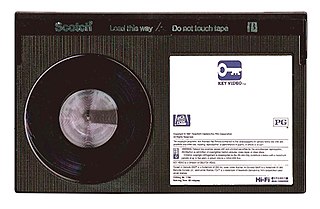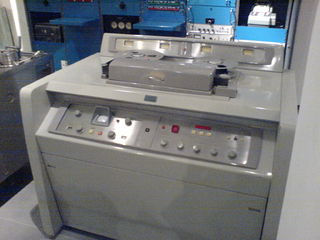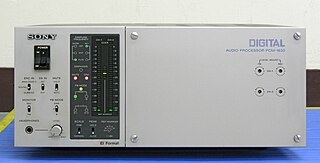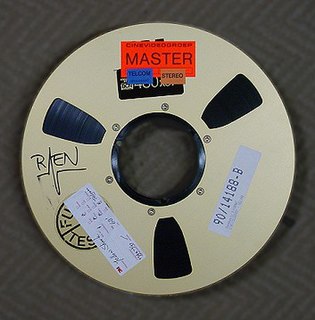
VHS is a standard for consumer-level analog video recording on tape cassettes.

DV refers to a family of codecs and tape formats used for storing digital video, launched in 1995 by a consortium of video camera manufacturers led by Sony and Panasonic. In the late 1990s and early 2000s, DV was strongly associated with the transition from analog to digital desktop video production, and also with several enduring "prosumer" camera designs such as the Sony VX-1000. DV is sometimes referred to as MiniDV, which was the most popular tape format using a DV codec during this time.

Videotape is magnetic tape used for storing video and usually sound in addition. Information stored can be in the form of either an analog signal or digital signal. Videotape is used in both video tape recorders (VTRs) or, more commonly, videocassette recorders (VCRs) and camcorders. Videotapes are also used for storing scientific or medical data, such as the data produced by an electrocardiogram.

S-VHS (スーパー・ヴィエイチエス), the common initialism for Super VHS, is an improved version of the VHS standard for consumer-level video recording. Victor Company of Japan introduced S-VHS in Japan in April 1987 with their JVC-branded HR-S7000 VCR, and in certain overseas markets soon afterward. Shortly, later in the same year of 1987, first S-VHS VCR models from other competitors included Hitachi VT-2700A, Mitsubishi HS-423UR, Panasonic PV-S4764, and Toshiba SV-950.

Betamax is a consumer-level analog-recording and cassette format of magnetic tape for video, commonly known as a video cassette recorder. It was developed by Sony and was released in Japan on May 10, 1975, followed by the US in November of the same year.

Helical scan is a method of recording high-frequency signals on magnetic tape. It is used in open-reel video tape recorders, video cassette recorders, digital audio tape recorders, and some computer tape drives.

A camcorder is a self-contained portable electronic device with video capture and recording as its primary function. It is typically equipped with an articulating screen mounted on the left side, a belt to facilitate holding on the right side, hot-swappable battery facing towards the user, hot-swappable recording media, and an internally contained quiet optical zoom lens.

Betacam is a family of half-inch professional videocassette products developed by Sony in 1982. In colloquial use, "Betacam" singly is often used to refer to a Betacam camcorder, a Betacam tape, a Betacam video recorder or the format itself.

A video tape recorder (VTR) is a tape recorder designed to record and play back video and audio material from magnetic tape. The early VTRs were open-reel devices that record on individual reels of 2-inch-wide tape. They were used in television studios, serving as a replacement for motion picture film stock and making recording for television applications cheaper and quicker. Beginning in 1963, videotape machines made instant replay during televised sporting events possible. Improved formats, in which the tape was contained inside a videocassette, were introduced around 1969; the machines which play them are called videocassette recorders.

A tape head is a type of transducer used in tape recorders to convert electrical signals to magnetic fluctuations and vice versa. They can also be used to read credit/debit/gift cards because the strip of magnetic tape on the back of a credit card stores data the same way that other magnetic tapes do. Cassettes, reel-to-reel tapes, 8-tracks, VHS tapes, and even floppy disks and modern hard drive disks all use the same principle of physics to store and read back information. The medium is magnetized in a pattern. It then moves at a constant speed over an electromagnet. Since the moving tape is carrying a changing magnetic field with it, it induces a varying voltage across the head. That voltage can then be amplified and connected to speakers in the case of audio, or measured and sorted into ones and zeroes in the case of digital data.

The 8mm video format refers informally to three related videocassette formats for the NTSC and PAL/SECAM television systems. These are the original Video8 format and its improved successor Hi8, as well as a more recent digital recording format known as Digital8.
A recording head is the physical interface between a recording apparatus and a moving recording medium. Recording heads are generally classified according to the physical principle that allows them to impress their data upon their medium. A recording head is often mechanically paired with a playback head, which, though proximal to, is often discrete from the record head.

U-matic is an analogue recording videocassette format first shown by Sony in prototype in October 1969, and introduced to the market in September 1971. It was among the first video formats to contain the videotape inside a cassette, as opposed to the various reel-to-reel or open-reel formats of the time. The videotape is 3⁄4 in (19 mm) wide, so the format is often known as "three-quarter-inch" or simply "three-quarter", compared to open reel videotape formats in use, such as 1 in (25 mm) type C videotape and 2 in (51 mm) quadruplex videotape.

A PCM adaptor is a device that encodes digital audio as video for recording on a videocassette recorder. The adapter also has the ability to decode a video signal back to digital audio for playback. This digital audio system was used for mastering early compact discs.
MII is a professional analog recording videocassette format developed by Panasonic in 1986 in competition with Sony's Betacam SP format. It was technically similar to Betacam SP, using metal-formulated tape loaded in the cassette, and utilizing component video recording.
M is the name of a professional analog videocassette format created around 1982 by Matsushita and RCA. Developed as a competitor to Sony's Betacam format, M used the same videocassette as VHS, much the same way that Betacam was designed to take advantage of cheap and readily available Betamax videocassettes,

1–inch type B VTR is a reel-to-reel analog recording video tape format developed by the Bosch Fernseh division of Bosch in Germany in 1976. The magnetic tape format became the broadcasting standard in continental Europe, but adoption was limited in the United States and United Kingdom, where the Type C videotape VTR met with greater success.
V-Cord is an analog recording videocassette format developed and released by Sanyo. V-Cord was released in 1974, and could record 60 minutes on a cassette. V-Cord II, released in 1976, could record 120 minutes on a V-Cord II cassette.

D6 HDTV VTR is SMPTE videocassette standard. A D6 VTR can record and playback HDTV video uncompressed. The only D6 VTR product is the Philips, now Thomson's Grass Valley's Media Recorder, model DCR 6024, also called the D6 Voodoo VTR. The VTR was a joint project between Philips Digital Video Systems of Germany and Toshiba in Japan. The tape deck module was designed and made by Philips in Weiterstadt, Germany, and the digital processor module designed and made by Toshiba. Since there is no data compression, after 20 tape copies of multi generations there is no noticeable loss of quality. As a very high-end, costly system about 70 were sold to high-end post houses from about 2000 to 2005. The VTR had a data record option. The data module could record and play back 2k DPX files at 6 frames per second over a HIPPI connection. The VTR came in a data only model, or with a switch module, so the record deck could be used for both video and data recording. The tape deck was also sold stand alone as a giga bit recorder to record and playback raw data. Toshiba made the video tape for the VTR. The high price of the video tape limited the use of the VTR.

A videocassette recorder (VCR) or video recorder is an electromechanical device that records analog audio and analog video from broadcast television or other source on a removable, magnetic tape videocassette, and can play back the recording. Use of a VCR to record a television program to play back at a more convenient time is commonly referred to as timeshifting. VCRs can also play back prerecorded tapes. In the 1980s and 1990s, prerecorded videotapes were widely available for purchase and rental, and blank tapes were sold to make recordings.

















